2021 HONDA CLARITY FUEL CELL flat tire
[x] Cancel search: flat tirePage 6 of 555
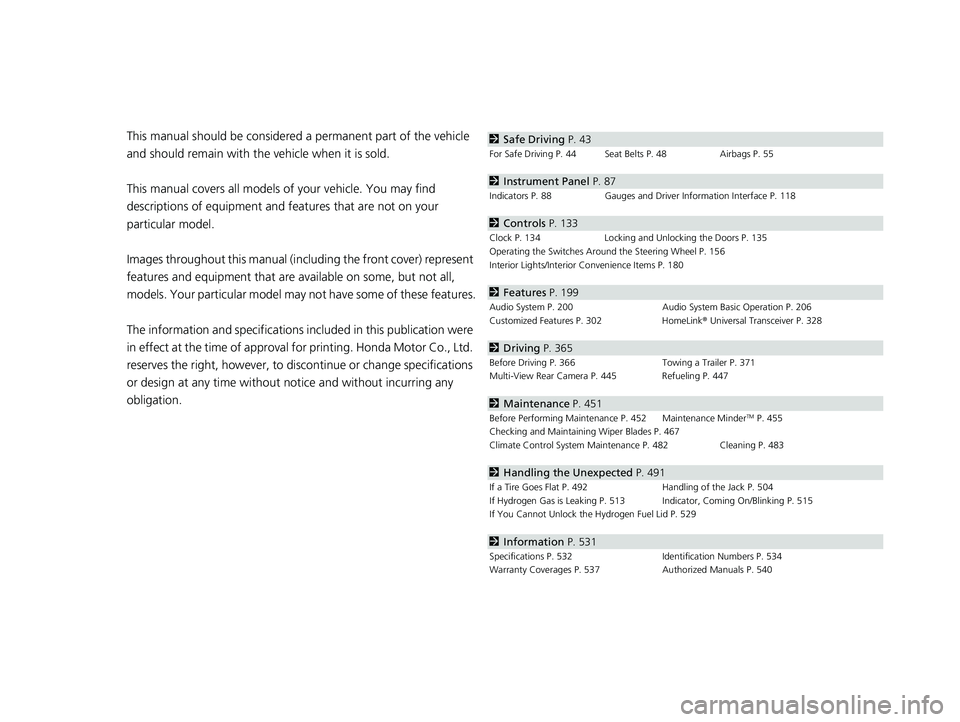
Contents
This manual should be considered a permanent part of the vehicle
and should remain with the vehicle when it is sold.
This manual covers all models of your vehicle. You may find
descriptions of equipment and features that are not on your
particular model.
Images throughout this manual (including the front cover) represent
features and equipment that are available on some, but not all,
models. Your particular model may no t have some of these features.
The information and specifications in cluded in this publication were
in effect at the time of approval for printing. Honda Motor Co., Ltd.
reserves the right, however, to discontinue or change specifications
or design at any time without notice and without incurring any
obligation.2 Safe Driving P. 43
For Safe Driving P. 44 Seat Belts P. 48 Airbags P. 55
2Instrument Panel P. 87
Indicators P. 88 Gauges and Driver Information Interface P. 118
2Controls P. 133
Clock P. 134 Locking and Unlocking the Doors P. 135
Operating the Switches Ar ound the Steering Wheel P. 156
Interior Lights/Interior Convenience Items P. 180
2 Features P. 199
Audio System P. 200 Audio System Basic Operation P. 206
Customized Features P. 302 HomeLink® Universal Transceiver P. 328
2 Driving P. 365
Before Driving P. 366 Towing a Trailer P. 371
Multi-View Rear Camera P. 445 Refueling P. 447
2 Maintenance P. 451
Before Performing Maintenance P. 452 Maintenance MinderTM P. 455
Checking and Maintaining Wiper Blades P. 467
Climate Control System Main tenance P. 482 Cleaning P. 483
2Handling the Unexpected P. 491
If a Tire Goes Flat P. 492 Handling of the Jack P. 504
If Hydrogen Gas is Leaking P. 513 Indicator, Coming On/Blinking P. 515
If You Cannot Unlock the Hydrogen Fuel Lid P. 529
2 Information P. 531
Specifications P. 532 Identification Numbers P. 534
Warranty Coverages P. 537 Authorized Manuals P. 540
21 CLARITY FCV CSS-31TRT6400_02.book 4 ページ 2020年9月25日 金曜日 午後3時15分
Page 23 of 555
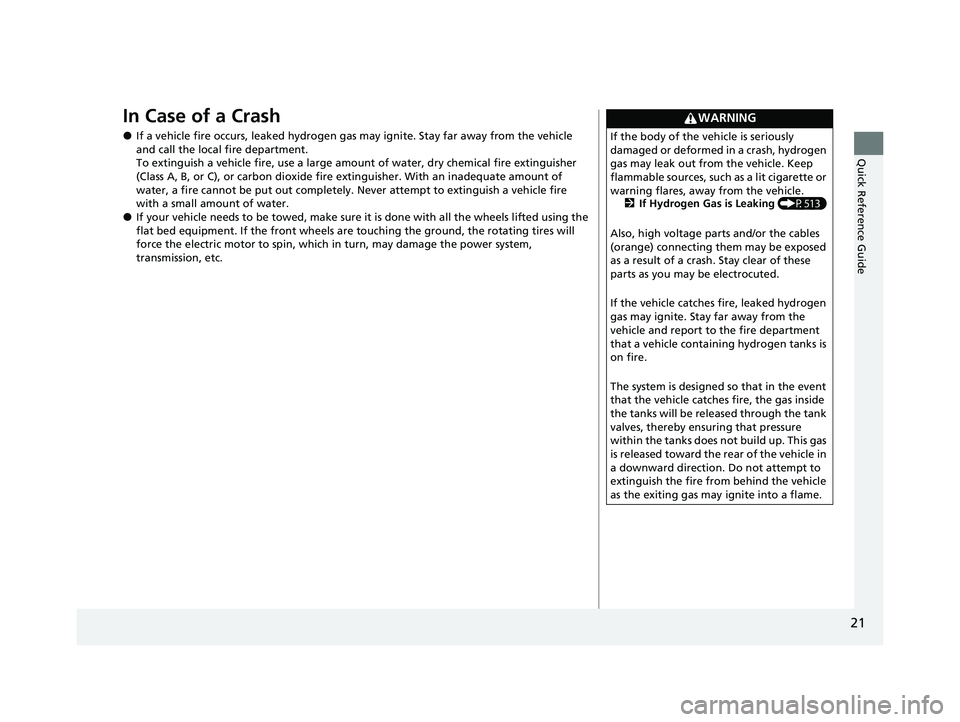
21
Quick Reference Guide
In Case of a Crash
●If a vehicle fire occurs, leaked hydrogen gas may ignite. Stay far away from the vehicle
and call the local fire department.
To extinguish a vehicle fire, use a large amount of water, dry chemical fire extinguisher
(Class A, B, or C), or carbon dioxide fire extinguisher. With an inadequate amount of
water, a fire cannot be put out completely. Never attempt to extinguish a vehicle fire
with a small amount of water.
●If your vehicle needs to be towed, make sure it is done with all the wheels lifted using the
flat bed equipment. If the front wheels are touching the ground, the rotating tires will
force the electric motor to spin, which in turn, may damage the power system,
transmission, etc.
WARNING
If the body of the vehicle is seriously
damaged or deformed in a crash, hydrogen
gas may leak out from the vehicle. Keep
flammable sources, such as a lit cigarette or
warning flares, away from the vehicle. 2If Hydrogen Gas is Leaking (P513)
Also, high voltage parts and/or the cables
(orange) connecting them may be exposed
as a result of a crash. Stay clear of these
parts as you may be electrocuted.
If the vehicle catches fire, leaked hydrogen
gas may ignite. Stay far away from the
vehicle and report to the fire department
that a vehicle containing hydrogen tanks is
on fire.
The system is designed so that in the event
that the vehicle catches fire, the gas inside
the tanks will be released through the tank
valves, thereby ensuring that pressure
within the tanks does not build up. This gas
is released toward the rear of the vehicle in
a downward direction. Do not attempt to
extinguish the fire from behind the vehicle
as the exiting gas may ignite into a flame.
21 CLARITY FCV CSS-31TRT6400_02.book 21 ページ 2020年9月25日 金曜日 午後3時15分
Page 40 of 555
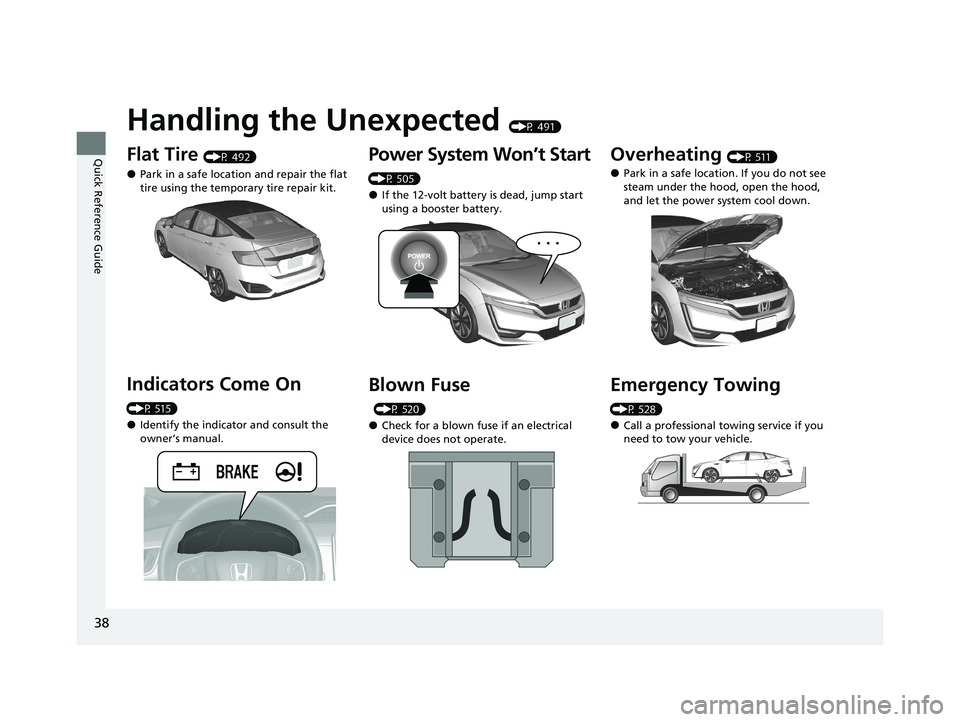
38
Quick Reference Guide
Handling the Unexpected (P 491)
Flat Tire (P 492)
●Park in a safe location and repair the flat
tire using the temporary tire repair kit.
Indicators Come On
(P 515)
●Identify the indicator and consult the
owner’s manual.
Power System Won’t Start
(P 505)
●If the 12-volt battery is dead, jump start
using a booster battery.
Blown Fuse
(P 520)
●Check for a blown fuse if an electrical
device does not operate.
Overheating (P 511)
●Park in a safe location. If you do not see
steam under the hood, open the hood,
and let the power system cool down.
Emergency Towing
(P 528)
●Call a professional towing service if you
need to tow your vehicle.
21 CLARITY FCV CSS-31TRT6400_02.book 38 ページ 2020年9月25日 金曜日 午後3時15分
Page 42 of 555
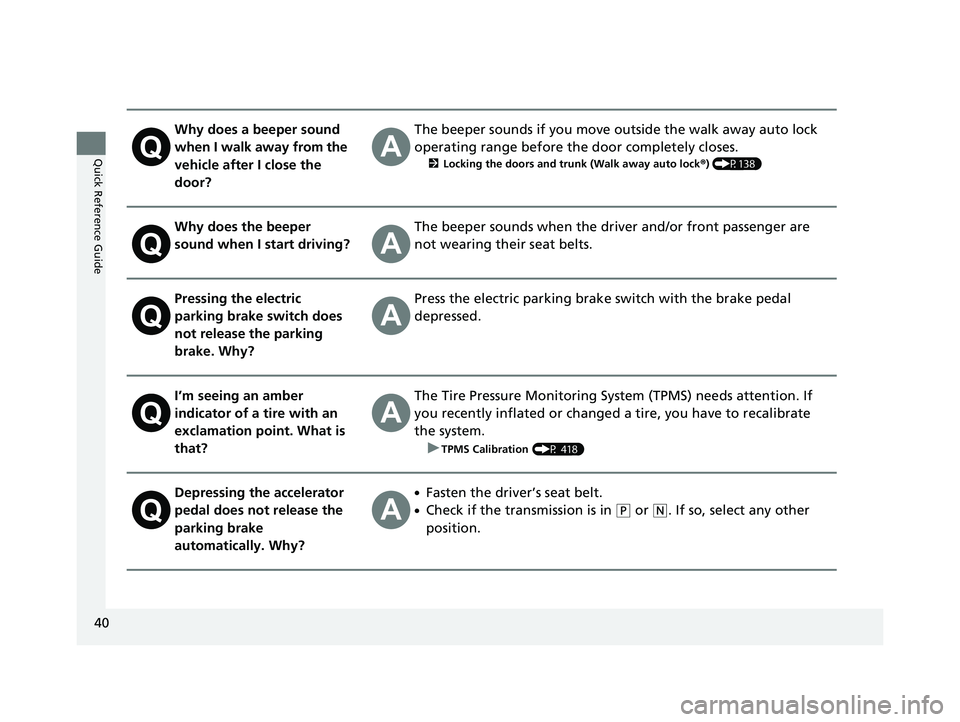
40
Quick Reference Guide
Why does a beeper sound
when I walk away from the
vehicle after I close the
door?The beeper sounds if you move outside the walk away auto lock
operating range before the door completely closes.
2Locking the doors and trunk (Walk away auto lock ®) (P138)
Why does the beeper
sound when I start driving?The beeper sounds when the driver and/or front passenger are
not wearing their seat belts.
Pressing the electric
parking brake switch does
not release the parking
brake. Why?Press the electric parking brake switch with the brake pedal
depressed.
I’m seeing an amber
indicator of a tire with an
exclamation point. What is
that?The Tire Pressure Monitoring Syst em (TPMS) needs attention. If
you recently inflated or changed a tire, you have to recalibrate
the system.
u
TPMS Calibration (P 418)
Depressing the accelerator
pedal does not release the
parking brake
automatically. Why?●Fasten the driver’s seat belt.
●Check if the transmission is in (P or (N. If so, select any other
position.
21 CLARITY FCV CSS-31TRT6400_02.book 40 ページ 2020年9月25日 金曜日 午後3時15分
Page 98 of 555
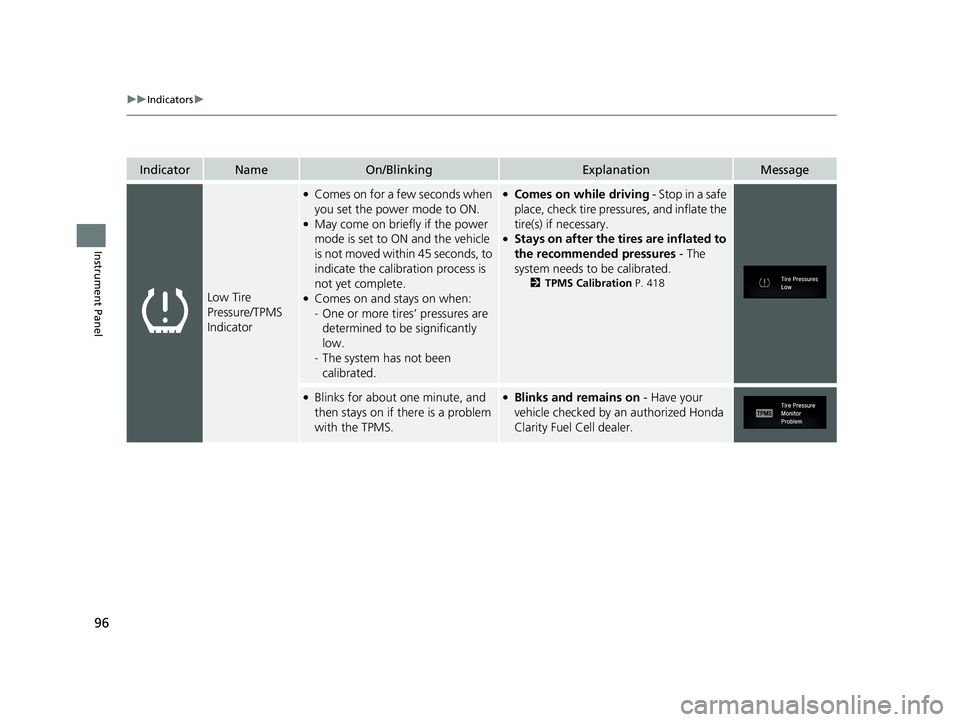
96
uuIndicators u
Instrument Panel
IndicatorNameOn/BlinkingExplanationMessage
Low Tire
Pressure/TPMS
Indicator
●Comes on for a few seconds when
you set the power mode to ON.
●May come on briefly if the power
mode is set to ON and the vehicle
is not moved within 45 seconds, to
indicate the calibration process is
not yet complete.
●Comes on and stays on when:
-One or more tires’ pressures are
determined to be significantly
low.
- The system has not been
calibrated.
●Comes on while driving - Stop in a safe
place, check tire pressures, and inflate the
tire(s) if necessary.
●Stays on after the tires are inflated to
the recommended pressures - The
system needs to be calibrated.
2 TPMS Calibration P. 418
●Blinks for about one minute, and
then stays on if th ere is a problem
with the TPMS.●Blinks and remains on - Have your
vehicle checked by an authorized Honda
Clarity Fuel Cell dealer.
21 CLARITY FCV CSS-31TRT6400_02.book 96 ページ 2020年9月25日 金曜日 午後3時15分
Page 392 of 555
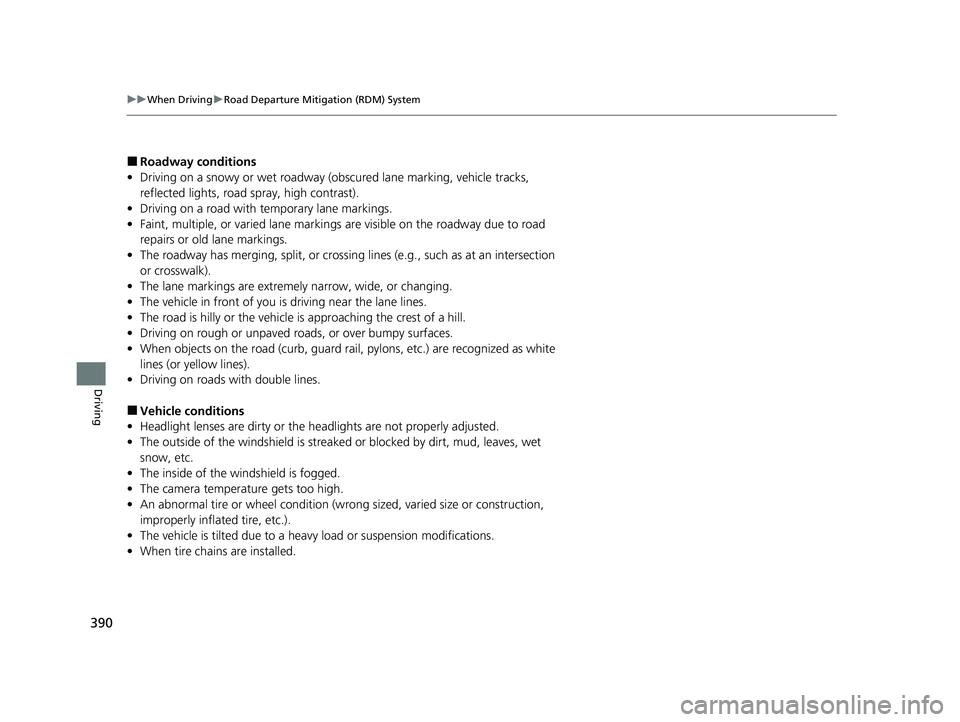
390
uuWhen Driving uRoad Departure Mitigation (RDM) System
Driving
■Roadway conditions
• Driving on a snowy or wet roadway (obscured lane marking, vehicle tracks,
reflected lights, road spray, high contrast).
• Driving on a road with temporary lane markings.
• Faint, multiple, or varied lane markings are visible on the roadway due to road
repairs or old lane markings.
• The roadway has merging, split, or crossing lines (e.g., such as at an intersection
or crosswalk).
• The lane markings are extremely narrow, wide, or changing.
• The vehicle in front of you is driving near the lane lines.
• The road is hilly or the vehicle is approaching the crest of a hill.
• Driving on rough or unpaved roads, or over bumpy surfaces.
• When objects on the road (c urb, guard rail, pylons, etc.) are recognized as white
lines (or yellow lines).
• Driving on roads with double lines.
■Vehicle conditions
• Headlight lenses are dirty or the headlights are not properly adjusted.
• The outside of the windshield is streake d or blocked by dirt, mud, leaves, wet
snow, etc.
• The inside of the windshield is fogged.
• The camera temperature gets too high.
• An abnormal tire or wheel condition (wrong sized, varied size or construction,
improperly inflated tire, etc.).
• The vehicle is tilted due to a heav y load or suspension modifications.
• When tire chains are installed.
21 CLARITY FCV CSS-31TRT6400_02.book 390 ページ 2020年9月25日 金曜日 午 後3時15分
Page 400 of 555
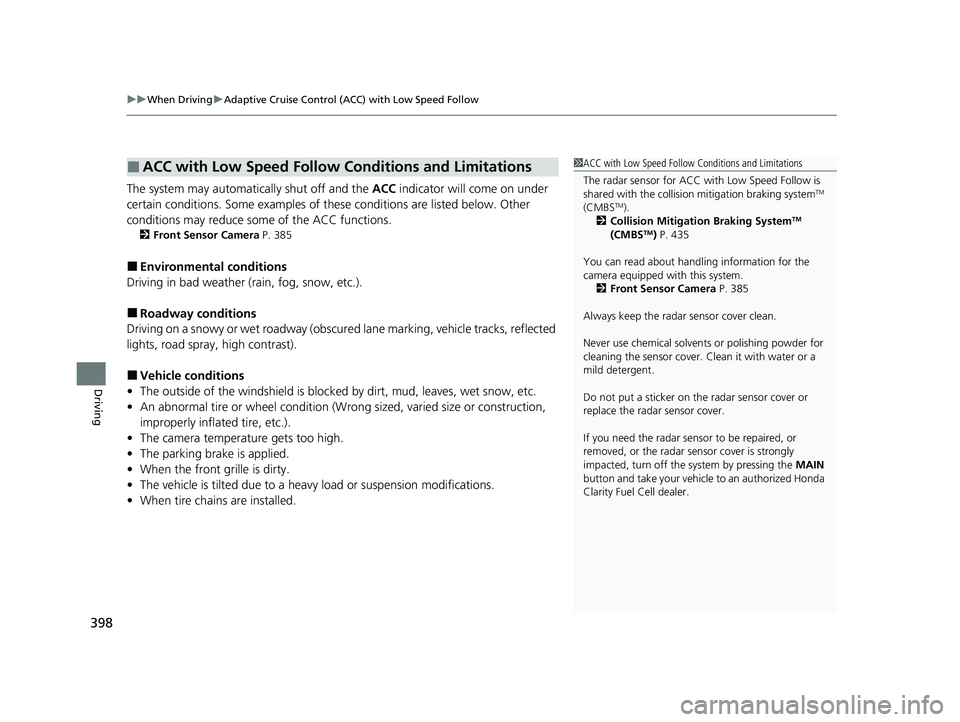
uuWhen Driving uAdaptive Cruise Control (ACC) with Low Speed Follow
398
Driving
The system may automatically shut off and the ACC indicator will come on under
certain conditions. Some examples of th ese conditions are listed below. Other
conditions may reduce some of the ACC functions.
2 Front Sensor Camera P. 385
■Environmental conditions
Driving in bad weather (r ain, fog, snow, etc.).
■Roadway conditions
Driving on a snowy or wet roadway (obscure d lane marking, vehicle tracks, reflected
lights, road spray, high contrast).
■Vehicle conditions
• The outside of the windshie ld is blocked by dirt, mud, leaves, wet snow, etc.
• An abnormal tire or wheel condition (Wrong sized, varied size or construction,
improperly inflated tire, etc.).
• The camera temperature gets too high.
• The parking brake is applied.
• When the front grille is dirty.
• The vehicle is tilted due to a heav y load or suspension modifications.
• When tire chains are installed.
■ACC with Low Speed Follow Conditions and Limitations1ACC with Low Speed Follow Conditions and Limitations
The radar sensor for ACC with Low Speed Follow is
shared with the collision mitigation braking system
TM
(CMBSTM).
2 Collision Mitigation Braking SystemTM
(CMBSTM) P. 435
You can read about handling information for the
camera equipped with this system. 2 Front Sensor Camera P. 385
Always keep the radar sensor cover clean.
Never use chemical solvents or polishing powder for
cleaning the sensor cover. Clean it with water or a
mild detergent.
Do not put a sticker on the radar sensor cover or
replace the radar sensor cover.
If you need the radar sensor to be repaired, or
removed, or the radar se nsor cover is strongly
impacted, turn off the system by pressing the MAIN
button and take your vehicl e to an authorized Honda
Clarity Fuel Cell dealer.
21 CLARITY FCV CSS-31TRT6400_02.book 398 ページ 2020年9月25日 金曜日 午 後3時15分
Page 416 of 555
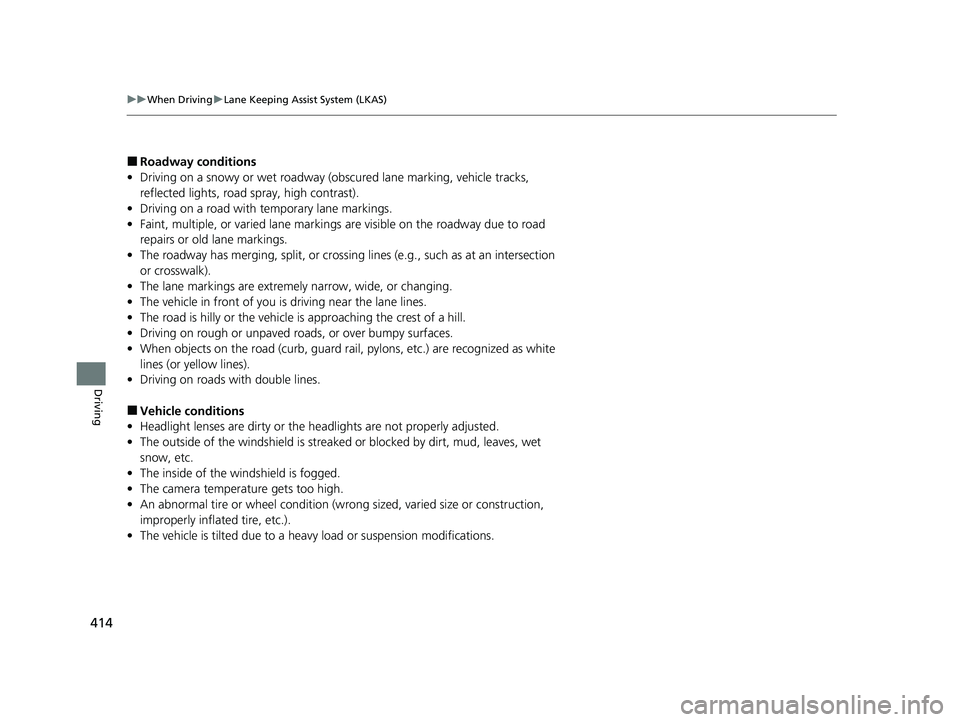
414
uuWhen Driving uLane Keeping Assist System (LKAS)
Driving
■Roadway conditions
• Driving on a snowy or wet roadway (obscured lane marking, vehicle tracks,
reflected lights, road spray, high contrast).
• Driving on a road with temporary lane markings.
• Faint, multiple, or varied lane markings are visible on the roadway due to road
repairs or old lane markings.
• The roadway has merging, split, or crossing lines (e.g., such as at an intersection
or crosswalk).
• The lane markings are extremely narrow, wide, or changing.
• The vehicle in front of you is driving near the lane lines.
• The road is hilly or the vehicle is approaching the crest of a hill.
• Driving on rough or unpaved roads, or over bumpy surfaces.
• When objects on the road (c urb, guard rail, pylons, etc.) are recognized as white
lines (or yellow lines).
• Driving on roads with double lines.
■Vehicle conditions
• Headlight lenses are dirty or the headlights are not properly adjusted.
• The outside of the windshield is streake d or blocked by dirt, mud, leaves, wet
snow, etc.
• The inside of the windshield is fogged.
• The camera temperature gets too high.
• An abnormal tire or wheel condition (wrong sized, varied size or construction,
improperly inflated tire, etc.).
• The vehicle is tilted due to a heav y load or suspension modifications.
21 CLARITY FCV CSS-31TRT6400_02.book 414 ページ 2020年9月25日 金曜日 午 後3時15分